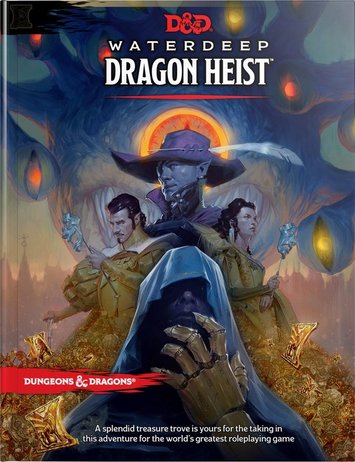 Wizards of the Coast recently released Waterdeep: Dragon Heist into the wild and it is a unique take on their usual two hundred fifty plus hardback adventures. Instead of starting at level five and going to fifteen or past, this adventure is purely tier one, levels one to four (five by the end). Wizards had Kobold Press do something similar in the beginning of fifth edition with Hoard of the Dragon Queen and Rise of Tiamat, but this is the first hardback that focuses on the lowest levels and newer dungeon masters. Wizards has a habit of writing adventures for people who have played Dungeons and Dragons before, leaving a lot of advice, technique and common issues left out. Waterdeep: Dragon Heist does a good job of putting options and comments in the text that encourage good gaming habits. 1) Useable Maps Although a printed Mike Schley map looks great on the table, a drawn map is a more common occurrence at the tables I’ve played at. Instead of the usual (albeit beautiful) Schley painted maps we have more generic Dyson Logos maps. Dyson has a simplistic, gameable style that translates well to the battle maps that most of us use for our games. Also, these maps are smaller and lend themselves to be used over and over; in fact the book leads the new dungeon master to this conclusion. 2) Replayability There are often things written in adventures directed to entertain the dungeon master while reading that the players will never see. This book takes that a step further and gives you four ten step paths reusing the same ten maps as different locations each time. Again, this promotes good dungeon master habits (reuse, repurpose, and steal) in new dungeon masters and keeps the dungeon master entertained on subsequent playthroughs of the hardback. Getting your fifty dollars out of a product has never been this fun. A dungeon master can run this for the same group and only the first two chapter are the same, and even those will likely play out different as the second is very free form and weather effects will wreak havoc on the players’ plans. 3) Leads Dungeon Masters In the Right Direction When Things Go Wrong It’s said that no plan survives contact with the enemy, this is true in Dungeons and Dragons as well. When four minds go up against one, those four players will always think of things the dungeon master has forgotten. For example, when a non player character is mentioned they let the dungeon master know that if that NPC is dead or otherwise removed from play they can just be substituted with a generic version of them. There are also many ideas of how to handle the situation when those players go sideways or get stuck in the story. 4) Sandbox Done Right Starting at around level two, the players are given the option to do what they want. New and even seasoned players can get analyzation paralyzation when faced with more than three choices. When the dungeon master looks at you and asks, “What do you want to do?” a player will likely freeze up. In the sandbox chapter of Waterdeep: Dragon Heist, they don’t just dump you into a list of locations hundreds of miles apart (looking at you Storm King’s Thunder), but instead give you ideas of what the players can do and of things that can happen during this time. 5) Using Non Standard Rules Waterdeep: Dragon Heist could have stuck to the core rules and not made any changes to them, but instead Wizards again chooses to lead a new dungeon master into a good routine by suggesting that some things may not work the normal way. Using variant rules like “Skills with Different Abilities,” taking disadvantage to give another player advantage, or the addition of constant weather effects during each season, Wizards encourages a new dungeon master to look beyond the rules for options as they come up. 6) Obvious Money Sinks In each Dungeons & Dragons hardback adventure there is always an incredible influx of gold that the characters receive. Waterdeep: Dragon Heist expands upon some of the rules in the Dungeon Masters Guide for spending gold. Running a business is covered in the Dungeon Masters Guide, but setting one up isn’t. Waterdeep: Dragon Heist not only lets the dungeon master know how much gold is needed to repair and run the business, but also who players will need to talk to and what happens if players eschew the guilds. There are prices for some scrolls as well if the players wish to purchase them, I don’t remember seeing these anywhere else and will use them as a base when pricing scrolls in the future. In most Dungeons and Dragons official material there is a lack of advice for someone just starting to run games. As far as direct advice, there still is, but if you take a look at the habits Wizards is trying to develop in Waterdeep: Dragon Heist there is some great insights. While I’d rather see a section of advice, this is heading in a good direction. In fact, I think Wizards of the Coast finally out did the Starter Set adventure (Lost Mine of Phandelver) in ease of entry for a new gaming group. This would be my new recommendation for a dungeon master just starting if the price of the required books and dice wasn't so high. Richard Fraser has been roleplaying since the early days of Dungeons and Dragons and started with the red box in the eighties. He currently prefers to DM fifth edition D&D, though reads a lot of OSR and PbtA. He currently has podcast, Cockatrice Nuggets and maintains a blog, both of which can be found at www.slackernerds.com. Image source: 2018 Wizards of the Coast Leave a Reply. |
All blog materials created and developed by the staff here at High Level Games Archives
April 2023
Categories
All
|
Proudly powered by Weebly




 RSS Feed
RSS Feed